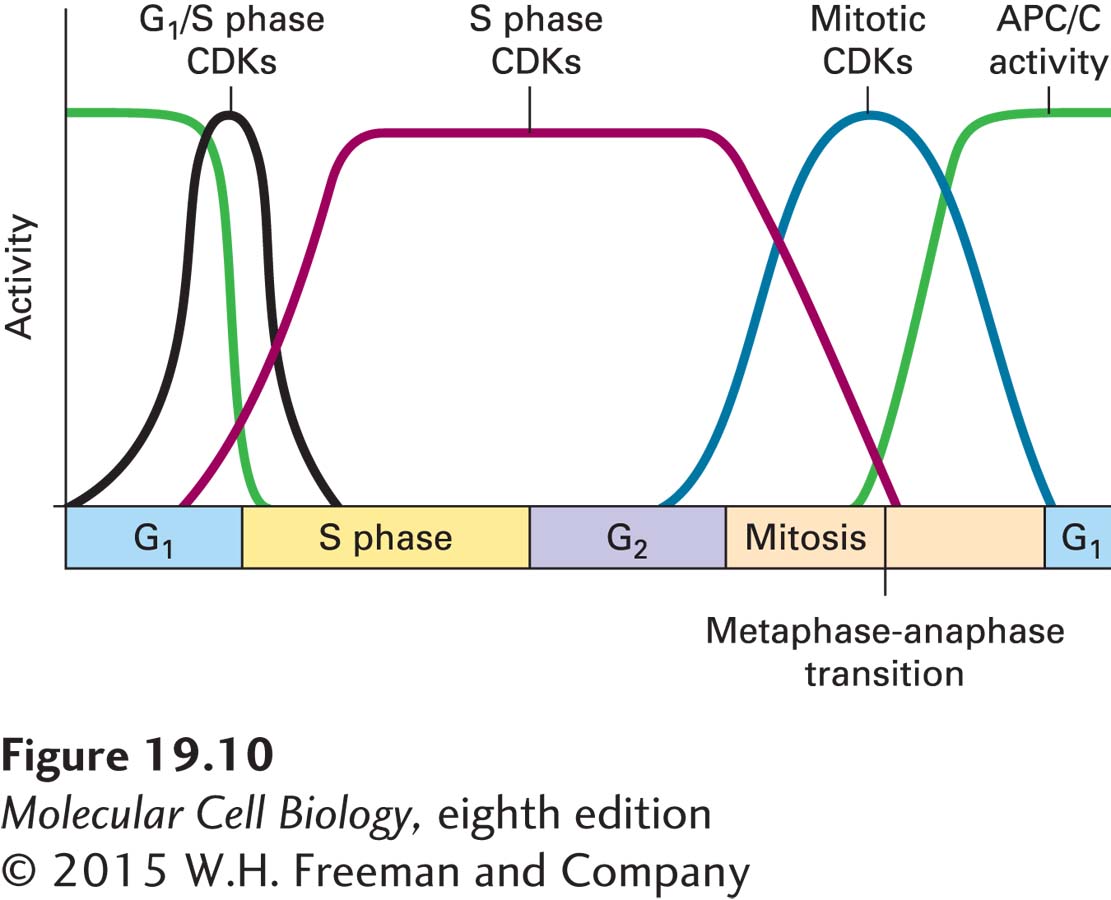In the following sections, we describe the current model of eukaryotic cell cycle regulation, which is summarized in Figure 19-9. A key discovery in cell cycle studies was that cyclin-dependent kinases govern progression through the cell cycle.

FIGURE 19-9 Regulation of cell cycle transitions. Cell cycle transitions are regulated by cyclin-CDK protein kinases, protein phosphatases, and ubiquitin-protein ligases. Here the cell cycle is diagrammed, with the major stages of mitosis shown at the top. In early G1, no cyclin-CDKs are active. In mid-G1, G1/S phase CDKs activate transcription of genes required for DNA replication. S phase is initiated by the SCF ubiquitin-protein ligase, which ubiquitinylates inhibitors of S phase CDKs, marking them for degradation by proteasomes. The S phase CDKs then activate DNA replication, and DNA synthesis commences. Once DNA replication is complete, cells enter G2. In late G2, mitotic CDKs trigger entry into mitosis. During prophase, the nuclear envelope breaks down and chromosomes align on the mitotic spindle, but they cannot separate until the anaphase-promoting complex (APC/C), a ubiquitin-protein ligase, ubiquitinylates the anaphase inhibitor protein securin, marking it for degradation by proteasomes. This results in degradation of protein complexes linking the sister chromatids and the onset of anaphase as the sister chromatids separate. APC/C also ubiquitinylates mitotic cyclins, causing their degradation by proteasomes. The resulting drop in mitotic CDK activity, along with the action of protein phosphatases, results in chromosome decondensation, reassembly of nuclear membranes around the daughter-cell nuclei, and cytokinesis.

FIGURE 19-10 An overview of how CDKs regulate cell cycle progression. Cells harbor different types of CDKs that initiate different events of the cell cycle. Importantly, the CDKs are active only in the stages of the cell cycle they trigger. G1/S phase CDKs are active at the G1–S phase transition to trigger entry into the cell cycle. S phase CDKs are active during S phase and trigger S phase. Mitotic CDKs are active during mitosis and trigger mitosis. The anaphase-promoting complex or cyclosome (APC/C) ubiquitin-protein ligase catalyzes two key cell cycle transitions by ubiquitinylating proteins, hence targeting them for degradation. APC/C initiates anaphase and exit from mitosis.
In this section, we first discuss the properties of CDKs and investigate the structural basis of their activation and regulation. We then describe how cyclins activate CDKs and investigate the multiple regulatory mechanisms that restrict the different cyclins to the appropriate cell cycle stage. We will see that protein degradation plays an essential part in this process. In addition, we will see how post-translational modifications to CDKs and inhibitory proteins that directly bind to cyclin-CDK complexes serve as essential additional control mechanisms in restricting different CDK activities to the appropriate cell cycle stage.

